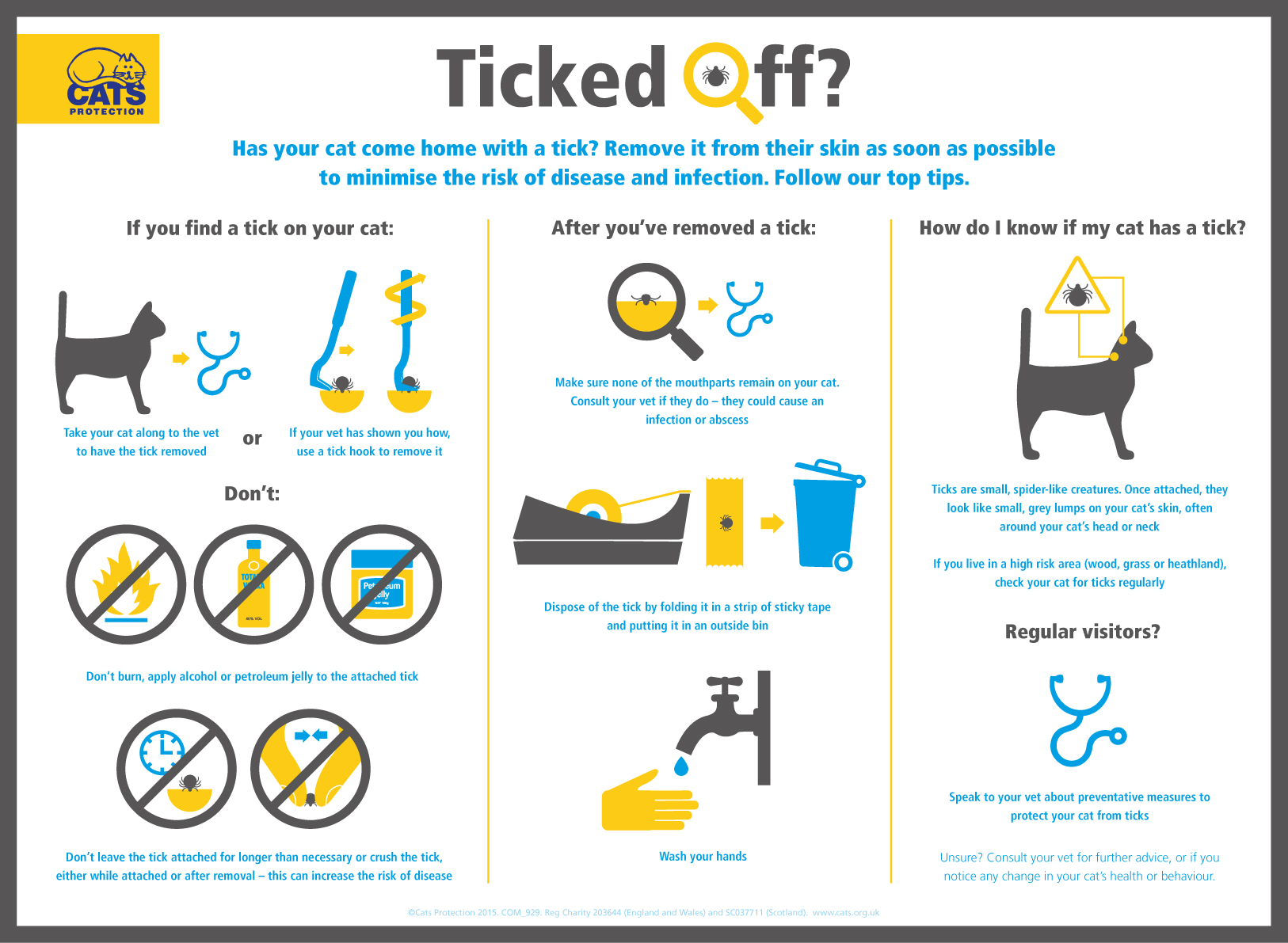Cats
Ticks are most commonly found on moorland and in long grass, or woodland and they can carry Lyme disease – although more prevalent in the USA – which can affect humans and animals.
If left untreated, ticks can cause infection, sore patches and abscesses. If your cat comes home with a tick (the first sign is a small dot attached to your cat’s skin but as it feeds it gets larger and can be mistaken for a wart or lump) it’s important to remove it as soon as possible.
Here are some top tips to deal with pesky ticks:
You can take your cat to the vet to have the tick removed, or if your vet has shown you how, you can use a tick hook to remove it yourself. Ensure the mouthparts are not left behind as they can lead to infection or an abscess.
Dispose of the tick by folding it in a strip of sticky tape and putting it in an outside bin and then thoroughly wash your hands.
Do not burn, apply alcohol or petroleum jelly to the attached tick or crush the tick as it can spread disease.
For more information on ticks and other parasites read our leaflet Fleas and other parasites.
Consult your vet for further advice, or if you notice any change in your cat’s health or behaviour.
- ‘what’s A Cat’s Ideal Weight?’ And Other Feline Veterinary Faqs
Want to know more about your cat’s health? Vet Vanessa Howie answered live questions from cat owners on our national Facebook page. Here’s a round-up of some of the queries she answered. Question: My cat is two years old and a tad on the porky side...
- Feline First Aid Faqs
Want to brush up on your feline first aid? Have a read of this blog post, summarising some of Cats Protection vet Vanessa Howie’s answers to our recent live first aid Q&A on Facebook. Question: With winter coming, what are the key symptoms of antifreeze...
- Your Cat’s Perfect Loo
Just like humans, cats like somewhere clean and comfortable to go to the toilet. This visual guide explains litter tray best practice. Learn how to give your cat the perfect litter tray experience! To enlarge, click on the imageLocation is everything:...
- Feline Behaviour Explained – Recognising Stress In Your Cat’s Face
In the last of a three-part series of visual guides to cat behaviour, we’re sharing some examples of facial expressions that will help you to identify how your cat is feeling and when they may be getting stressed. This is a general guide so your cat...
- Feline Behaviour Explained – Why Does My Cat…?
In the second of a three-part series of visual guides to cat behaviour, we’re examining common cat body behaviours. It is the very nature and behaviour of cats that makes them one of the UK’s most popular pets today. Their independence, playfulness...
Cats
How to remove a tick from your cat
Ticks are most commonly found on moorland and in long grass, or woodland and they can carry Lyme disease – although more prevalent in the USA – which can affect humans and animals.
If left untreated, ticks can cause infection, sore patches and abscesses. If your cat comes home with a tick (the first sign is a small dot attached to your cat’s skin but as it feeds it gets larger and can be mistaken for a wart or lump) it’s important to remove it as soon as possible.
Here are some top tips to deal with pesky ticks:
 |
| To enlarge, click on the image |
You can take your cat to the vet to have the tick removed, or if your vet has shown you how, you can use a tick hook to remove it yourself. Ensure the mouthparts are not left behind as they can lead to infection or an abscess.
Dispose of the tick by folding it in a strip of sticky tape and putting it in an outside bin and then thoroughly wash your hands.
Do not burn, apply alcohol or petroleum jelly to the attached tick or crush the tick as it can spread disease.
For more information on ticks and other parasites read our leaflet Fleas and other parasites.
Consult your vet for further advice, or if you notice any change in your cat’s health or behaviour.
Share this image on your site
- ‘what’s A Cat’s Ideal Weight?’ And Other Feline Veterinary Faqs
Want to know more about your cat’s health? Vet Vanessa Howie answered live questions from cat owners on our national Facebook page. Here’s a round-up of some of the queries she answered. Question: My cat is two years old and a tad on the porky side...
- Feline First Aid Faqs
Want to brush up on your feline first aid? Have a read of this blog post, summarising some of Cats Protection vet Vanessa Howie’s answers to our recent live first aid Q&A on Facebook. Question: With winter coming, what are the key symptoms of antifreeze...
- Your Cat’s Perfect Loo
Just like humans, cats like somewhere clean and comfortable to go to the toilet. This visual guide explains litter tray best practice. Learn how to give your cat the perfect litter tray experience! To enlarge, click on the imageLocation is everything:...
- Feline Behaviour Explained – Recognising Stress In Your Cat’s Face
In the last of a three-part series of visual guides to cat behaviour, we’re sharing some examples of facial expressions that will help you to identify how your cat is feeling and when they may be getting stressed. This is a general guide so your cat...
- Feline Behaviour Explained – Why Does My Cat…?
In the second of a three-part series of visual guides to cat behaviour, we’re examining common cat body behaviours. It is the very nature and behaviour of cats that makes them one of the UK’s most popular pets today. Their independence, playfulness...
